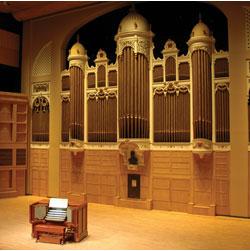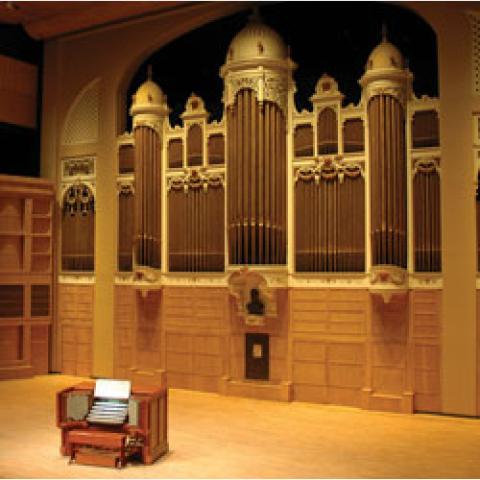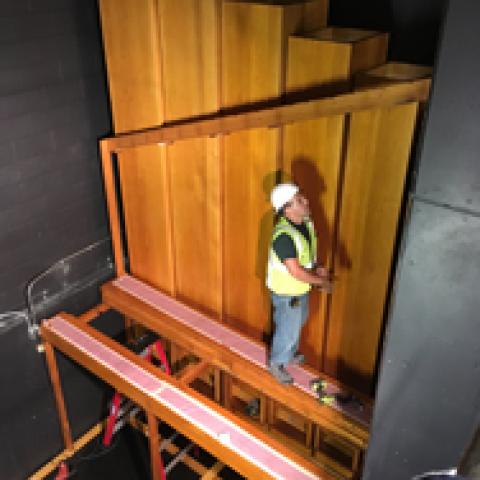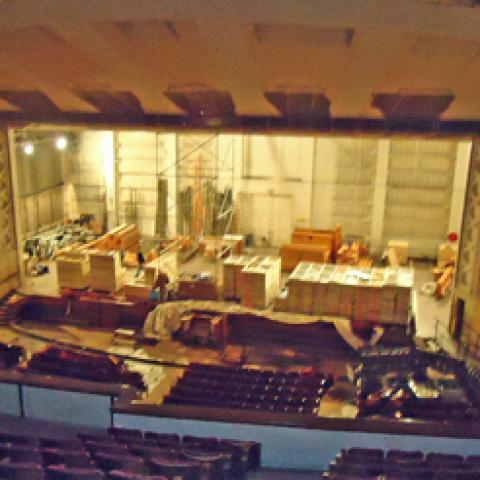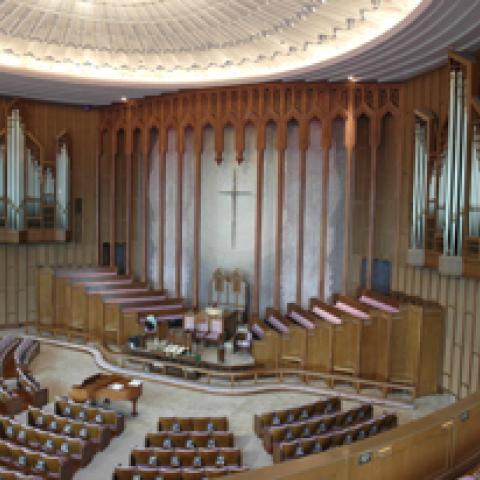For a century and a half, the name Kotzschmar has personified the outsized musical ambitions of the small city of Portland, Maine. Johann Carl Hermann Kotzschmar, who arrived in Portland in 1849 from his native Germany, became a leading citizen, beloved as teacher, organist, composer, and choral conductor. He lived at first with a Portland decorator and his wife, who then named their first child Cyrus Hermann Kotzschmar Curtis. Curtis grew up and went off to Philadelphia to become the fabulously wealthy publisher of the Saturday Evening Post, the Ladies’ Home Journal, and much else.
Two years after his namesake’s death in 1908, Curtis donated $30,000 towards a grand orchestral pipe organ for the auditorium of the new Portland City Hall that was being built after a disastrous fire had destroyed the old one. The new instrument was to be a municipal organ, owned and enjoyed by the citizenry, as a memorial to Hermann Kotzschmar, and with a municipal organist to do the honors. The first, Will C. Macfarlane, a noted organist and composer from New York City, dedicated the 69-rank instrument, Austin Organ Company Opus 323, on August 22, 1912.
Ever since, the Kotzschmar Memorial Organ has been a beloved part of Portland’s municipal life. With the city, it has been through hard times, enduring financial hardships and even scandals; and with the city, it has also enjoyed high points. Curtis came through with another large donation for a significant enlargement of the instrument in 1927, with the addition of numerous upperwork ranks in the Swell, a new 14-stop Antiphonal division added to the original Echo division chamber, in the ceiling of the hall high above the audience, and a full set of percussion “traps” from Snare Drum and Glockenspiel to Marimba. All in all, the organ is, as Thomas Murray has put it, “a wonderful work of art which represents the best thinking and skills of its time.”
That time was the early 20th century. But in the late 20th century, troubles multiplied. The organ was twice damaged by manhandling during renovations of the auditorium. City funds repeatedly ran short, and the organ went into decline in the 1970s. Premature demise was narrowly avoided in 1981 by grateful citizens who formed the Friends of the Kotzschmar Organ, Inc. (FOKO) to take over financial responsibility for the instrument. But three decades later, as its centennial approached in 2012 and its home, now named Merrill Auditorium, was again to be renovated, whether the organ could survive was again a real question.
The answer this time has been a resounding YES! from the people of the city, their elected officials, and other friends of the organ near and far and wide. All rallied to raise the money it took to restore and renovate the organ from top to bottom. Foley-Baker, Inc., the lead contractor, took the entire organ to its shops in Tolland, Connecticut, in summer 2012 and has overseen cleaning and revoicing of nearly 7,000 pipes and the building of additional ranks that bring the total to 104. Organ Supply Industries, Inc., Broome and Co. LLC, and A. R. Schopp’s Sons, Inc. all participated importantly in the work, and Austin Organs, Inc. provided needed parts. Foley-Baker built a completely new walk-in Austin Universal Windchest to the 1912 specifications of the original, 54 feet long, 8 feet wide, and 7 feet high inside, equipping it with the latest mechanical and digital technology. “All the thousands of valves and relays of manual motors are new—it was simpler to rebuild everything than it would have been to try to repair,” said Philip Carpenter, the project supervisor for Foley-Baker, which finished the new air box in mid-2013.
Portland’s 66,000 people paid for $1.25-million of the $2.6-million cost of the organ renovation with a municipal bond issue financed with a $2 surcharge on all Merrill Auditorium events—operas, symphonic concerts, plays, and shows. Friends of the organ from Portland and all over southern Maine, as well as “people from away” paid for the rest, and more. “Very few communities have been able to build and maintain and preserve an organ as important as this, and most of the ones that have are bigger than this one,” said Laurence H. Rubinstein, FOKO board president. “We raised a substantial amount of money—much larger communities have fallen on their faces trying to do what we have done.” The ultimate goal is $4 million to endow positions for the municipal organist (now Ray Cornils, in his 24th year in the post) and for a curator and set up a fund for visiting artists and education programs. The pipes will all be back in place by the end of summer 2014, and Portland will celebrate this happy ending with a gala concert on September 27 with Cornils, Wanamaker Grand Court organist Peter Richard Conte, and full brass choir and percussion in a specially commissioned celebratory work by the organist and composer Carson Cooman. “It will be a wide-ranging program, which will highlight the immense tonal and dynamic range of the Kotzschmar, along with its wonderful ability to work symphonically with and without other instruments,” Cornils said. The organ will also be heard in Janáček’s Glagolitic Mass with the Portland Symphony Orchestra, founded in 1923, on September 30.
The story of Portland’s municipal organists is as full of cliffhangers as the history of the organ itself. John Morgan, who succeeded Macfarlane in 1919, resigned unexpectedly two years later. He left town with a woman after convincing her that her husband was not the Portland engineer he appeared to be but actually the Mexican bandit Pancho Villa. The city then persuaded the famous Edwin H. Lemare to take the job, but he lasted only until 1923. That year, the municipal music commission then in charge of administering the organ program asked him to play hymns for a community service before his contracted ten Sunday afternoon recitals a year (in addition to twenty-five evening recitals). They wanted him to take a salary cut besides. “I was assured by the commission which engaged me that such services were never expected of me,” he objected; “The reason for the attitude of the present commission is, so I am informed by its chairman, lack of funds, owing to the previous commission’s engaging such expensive artists as the great Russian basso Fyodor Chaliapin at the last winter concerts.” In a huff, Lemare went off to Boston and then Chattanooga—there were plenty of municipal organs in those days, especially in cities too small to support orchestras (today only Portland and San Diego, with the outdoor Spreckels Organ, Austin Opus 453, still have them).
Lemare’s successor, Charles Raymond Cronham, stayed until the spring of 1932, when the commission, by this time in a real financial crisis because of the Great Depression, dismissed him and persuaded Macfarlane to come back for another term. Cronham insisted that the job was still his, and little wonder—he earned more in 1930 than the superintendent of schools. There was a standoff until the end of May, when Cronham threw in the towel, but then the city council refused the music commission’s request for money to pay Macfarlane. Bickering continued until late 1933, when the exasperated city council voted to abolish the commission. Macfarlane soon decamped, and Alfred Brinkler, an Englishman, was named municipal organist in 1935, keeping the job until 1952.
The organ’s troubles began during the tenure of his successor John Fay in 1968, when the City Hall auditorium’s stage was enlarged by moving the organ back 15 feet. The movers jacked the huge Universal Air Chest off its foundations, put the entire 30-ton framework on wheels on steel rails, and rolled it, façade and all, out of the way of the construction crews. A 10-foot section of the chest had to be removed to make room for a chimney from the auditorium’s boiler room before the organ was trundled back, and a 32′ Magnaton rank whose 32 pipes would not fit in the new location was removed, and later lost. During all the moving, the 12 large-scale 32′ Contra Bombarde pipes either fell or were knocked over, wrecking their metal resonators.
Without some of its deepest bass sounds, the organ was put back into playing order, but soon city funds were again running so short that funding for concerts was cut off. In 1971 the city’s Director of Aviation and Public Buildings (!) recommended that the Municipal Organ Department be shut down. That was staved off when Fay and fellow organists raised enough money privately for at least a few concerts to continue. Douglas Rafter, who succeeded Fay in 1976, persuaded donors to give money to gild the façade pipes, but the city council, still strapped, made clear that this time it really was ready to abolish the department and eliminate his post. He resigned before that happened, but it did, in 1981.
At that low point, the mayor of Portland was Pamela Plumb, whose husband, Peter S. Plumb, was an attorney—and an organist. Encouraged by her spouse, Mayor Plumb kept the organ alive, but despite the heroic efforts of its acting curator, Burt Witham, things were touch and go. When the Boston Symphony Orchestra organist, Berj Zamkochian, brought a group of people from Kennebunk one Sunday morning to see and hear the organ, he had to apologize for its condition—wheezing and ciphering, many notes not playing. One visitor, Abbott Pendergast, was moved to bring a check for $10,000 for the restoration of the organ and present it to Russ Burleigh, the manager of the Portland Symphony, on whose board Peter Plumb also served. The two of them decided that the best way to save the organ would be an independent group of supporters that, with the blessing of the city council but not dependent on it for funds, would take over financial responsibility for the organ and hire the municipal organist. Burleigh came up with its name, and FOKO was born on November 21, 1981, with Plumb as president and Burleigh as treasurer.
They hired a Portland organbuilder, David Wallace, to start repairs, one division at a time. “Less than 25% of the manual ranks worked,” Wallace later recalled. “The organ was choked with a thick layer of sooty dust and had so many air leaks that the softest stops could not be heard at all.” The windchest had never recovered from losing its base in the 1968 move. But for quick fixes and ad hoc repairs, funds began to come in, from the city as well as from private donors, and Wallace could begin work. He built wooden resonators on top of the bases of the 32′ Contra Bombarde pipes that had been wrecked, and put them back into the organ. As FOKO’s archivist, Janice Parkinson-Tucker, writes, “In ten years FOKO raised enough money that 90 percent of the organ was restored and tonally preserved.”
Ray Cornils became municipal organist in 1990 and soon became the personification of what the Kotzschmar Organ means to the city, through innovative educational and children’s programs and an annual “Christmas with Cornils” with organ, brass, handbells, and other instruments. A $9.7 million remodeling of the City Hall auditorium was to begin in 1995, however, requiring the removal of the stage organ once again, this time for two years. Cornils and the Friends took the concert program to St. Luke’s Cathedral on State Street, with its E.M. Skinner organ (Skinner Organ Co. Opus 699, 1928), and Wallace and the Organ Clearing House stored the Kotzschmar pipes in a nearby warehouse. Other work rebuilt the missing ten feet of the windchest, with pneumatic relays and solid-state controls. The 32′ Contra Magnaton that had been removed in 1968 was replaced with similar pipes that came from another Austin organ, Opus 279, at Smith College.
The reconstituted Kotzschmar organ was brought back and inaugurated again on April 22, 1997, in the hall, renamed Merrill Auditorium. The following year four donors, Anita and Charles Stickney and Sally and Malcolm White, gave $130,000 towards the purchase of a new Austin five-manual console, the fifth in the organ’s history.
But all the quick-fit patchwork over the years was not holding together for the long term. Within ten years, the giant windchest was leaking so much air that it was beginning to sound like a hovercraft. Working inside, technicians found that relays and contacts controlling the pipes above were corroded and unreliable. The pipes themselves were once again full of dust, and the voicing out of regulation. Metal fatigue let some pipes collapse on themselves.
The pedal bass stops that had been damaged and repaired were troublesome, and some of them could not be tuned. In early 2007, the FOKO board had raised some money and wanted to add a couple of new bass voices. But, as John Bishop, its organ committee chair, recalled, “We got an expert who came, with others, and inspected, but they said they couldn’t make additions to the organ because it was in such poor condition.”
What to do? The board decided to ask a panel of experts, who came that August. Its members—Peter Richard Conte; L. Curt Mangel III, curator of the Wanamaker Organ; Jonathan Ambrosino, organ expert and consultant; Thomas Murray, university organist and professor of music at Yale University; Nicholas Thompson-Allen and Joseph F. Dzeda, both of the A. Thompson-Allen Company, the curators of the Skinner orchestral organ in Yale’s Woolsey Hall auditorium; and Walter Strony, a noted theatre-organ performer—agreed unanimously in two days of deliberations that the Kotzschmar Organ was a national treasure with a global reputation, and recommended that FOKO should commission a thorough survey of how to dismantle, clean, repair, and rebuild it, and how to raise the money.
The board then hired Ambrosino to do a thorough study of what needed to be done, and Rubinstein and Plumb formed a fundraising campaign committee and began training volunteers. They quickly realized that having the project completed by 2012 would be impossible, and decided to make the centennial that year a festival that would launch the start rather than the completion of work. “We knew we had to raise at least $2.5 million, and we decided on a two-pronged strategy,” Rubinstein said; “Peter Plumb had great access to the city council, and when we approached the city, that did the trick.” In September 2011, the mayor then, Nicholas M. Mavodones Jr., and the rest of the city council voted to issue $1.5 million in bonds, $1.25 million to be matched by FOKO and the rest to make additional small improvements to Merrill Auditorium. “It wasn’t really debated at all,” said Bob Keyes, a Portland Press Herald reporter. “Nobody suggested that better things could be done with the money. The organ has always been universally supported.”
Four companies bid for the job after FOKO issued contract specifications, and it went to Foley-Baker, which had had experience dealing with work in busy auditoriums before, with the restorations and renovation of the Boston Symphony Hall Aeolian-Skinner and the Duke University Chapel Aeolian instruments. When the last note was played at the Kotzschmar’s centenary gala on August 22, 2012, Foley-Baker technicians came dramatically onstage and started taking down pipes. Later, Mike Foley, the company’s president, observed, “I don’t think we’ve ever worked on so high-profile an organ that was in such tough shape.”
The Friends and Cornils knew that the work would take two years and hit the road with educational outreach programs in schools, “Christmas with Cornils” and “Bach Birthday Bash” evenings in churches in Portland and other cities, and much else, to make sure nobody in Portland would think the Kotzschmar was not coming back. As the renovation progressed—the new air chest, large bass pipes, and expression boxes were all installed and work on the Echo and Antiphonal divisions was completed during the summer of 2013—they also hosted visits and crawl-throughs so that Portlanders and other donors could see what their money was doing.
The work this time is meant to last another century. Besides cleaning (especially impressive with the façade pipes, once again gleaming gold), re-regulation and some revoicing, the changes in the specification will be especially noticeable in the bass ranks of the pedal. The 32′ Contra Magnaton—only 12 pipes—from Smith College had never tonally fit in with the rest of the organ, and some of them had been badly damaged. They have now been put in storage behind the organ, replaced by twelve new wood Haskell basses that extend the organ’s original 16′ Open Wood stop, now renamed, to 32′. Another new stop, a metal Principal, also plays in the Pedal at 16′, 8′, and 4′, as well as on the Great at 8′.
A 32′ reed stop with only half-length resonators, the Contra Tuba, has been removed, and new full-length 32′ Contra Bombarde pipes with industrial-strength metal resonators replaced the wooden ones Wallace had supplied decades ago. A new V-rank Mixture in the Great replaces a IV-rank Mixture donated in 2002. The Swell has additions of a 4′ Octave and a 4′ Clarion.
The numerous tonal percussion stops above the Solo division have all been completely rebuilt and reconditioned, and the non-tonal cymbals and drums have been relocated to a position above the Orchestral division, along with some new toys: Birds, Car Horn, Door Bell, Train Whistle, Fire Gong, and Hoofs, among them. The five-manual console has been completely rebuilt and renovated.
All in all, it amounts to the glorious rebirth of a great American cultural monument. “The city of Portland is extremely appreciative of our community’s support, and of the Friends of the Kotzschmar Organ for being such great stewards of this historic instrument,” said the city’s current mayor, Michael F. Brennan; “We look forward to the return of this city treasure.”
—Craig R. Whitney
Cover photo credit: Len Levasseur
With appreciation for Janice Parkinson-Tucker’s Behind the Pipes: The Story of the Kotzschmar Organ and Hermann Kotzschmar: An Appreciation, published respectively in 2005 and 2006 by Casco House Publishing of South Portland, Maine.
